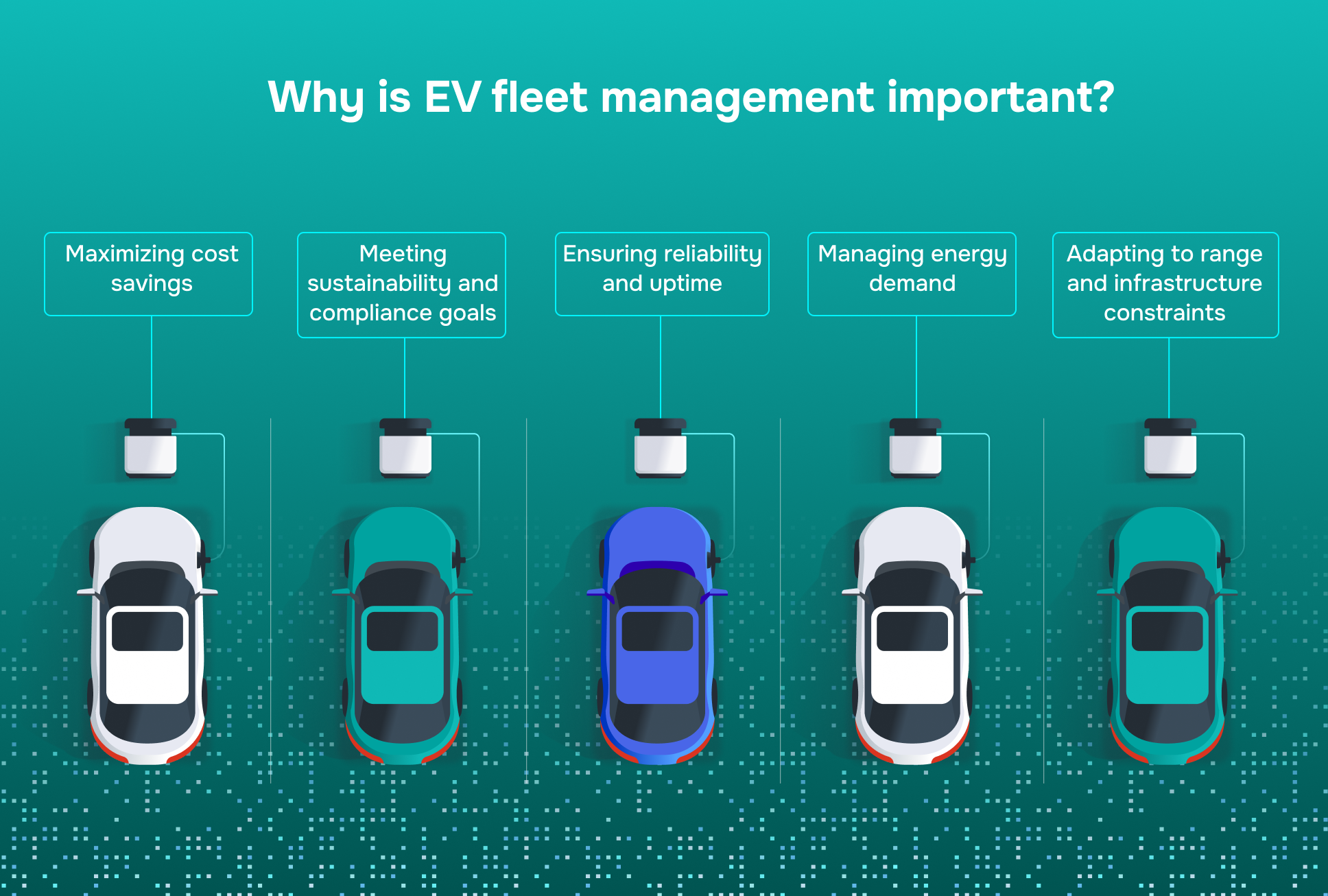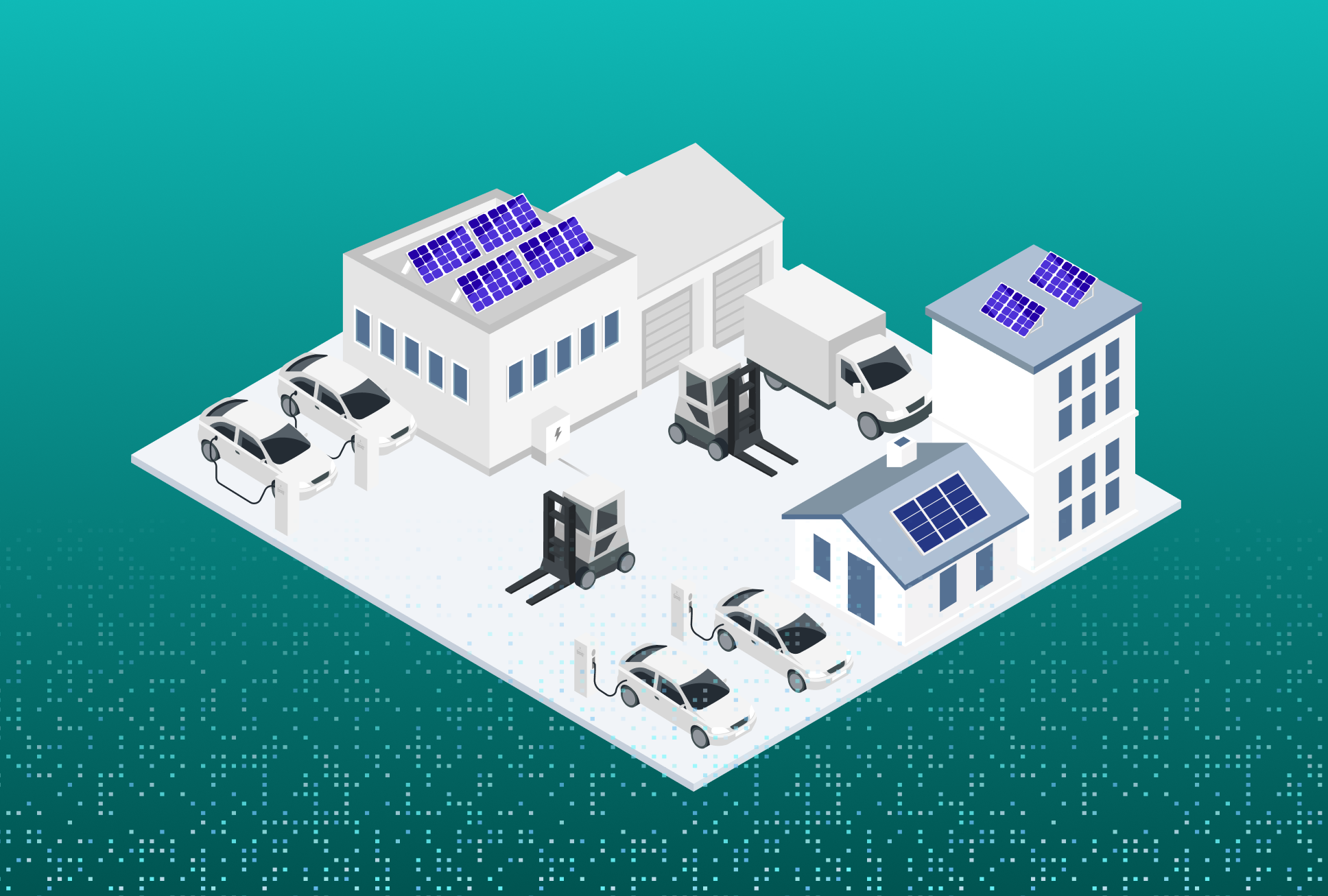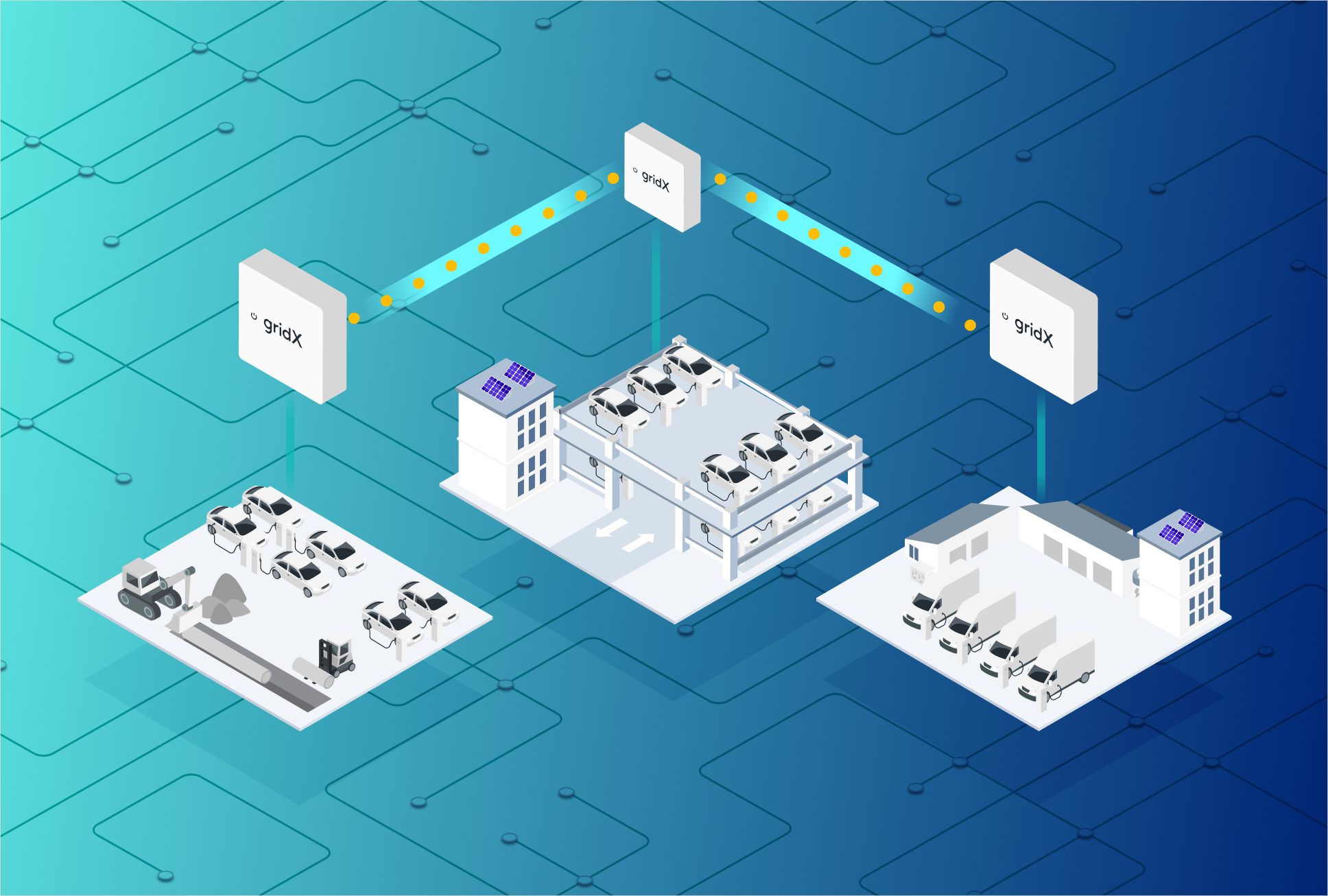Core functions of EV fleet management
At its core, EV fleet management involves everything required to keep electric vehicles operational and cost-effective on the road. This includes tasks that range from day-to-day charging schedules to long-term vehicle procurement and lifecycle planning.
Key aspects typically encompassed by EV fleet management are:
Charging infrastructure management
Planning, installing and maintaining sufficient charging stations to support the fleet’s energy needs (considering number of chargers, power capacity, and optimal locations). This ensures vehicles can charge conveniently at depots, workplaces or on route and at home, as more company car programs shift to EVs and employees regularly charge overnight.
Charging schedule optimization
Strategically scheduling when vehicles charge – for example, taking advantage of off-peak electricity rates to minimize energy costs and avoid straining the grid. By linking charging schedules with route management, fleet operators can adjust vehicle availability windows to better align with grid-friendly charging times, ensuring each EV is ready when needed without charging during expensive peak hours.
Energy usage monitoring and analytics
Collecting real-time data on charging behavior, energy consumption and vehicle performance to identify patterns and areas for improvement. Robust data reporting helps fleet managers make informed decisions to improve efficiency and reduce costs.
Driver training and policy
Educating drivers in efficient EV usage, such as gentle driving to extend range and proper charging practices. EVs have unique features like regenerative braking and different refueling routines; training helps drivers adapt and maximize the vehicles’ capabilities.
Maintenance management
Scheduling and performing maintenance specific to EVs (which generally have fewer moving parts than combustion vehicles). This includes battery health checks and software updates, ensuring each vehicle remains in peak condition with minimal downtime.
Regulatory compliance and sustainability
Ensuring the fleet’s operation complies with evolving regulations (for example, around EV charging or battery disposal) and contributes to company sustainability goals. EV fleet management often ties into corporate carbon reduction strategies and reporting.

Why is EV fleet management important?
Shifting from internal combustion engine (ICE) vehicles to EVs isn’t just a one-for-one swap; it introduces new logistical considerations around charging, vehicle deployment and energy management. EV fleet management is important because it helps fleet operators navigate these changes and reap the benefits of electrification. When done right, it goes beyond basic replacement and enables significant cost savings. Intelligently replanned systems have shown 8%–13% lower total cost of ownership (TCO) at the fleet level compared to all-diesel operations, while a simple 1:1 swap yielded just 3% savings, heavily reliant on CAPEX subsidies.
Some key reasons managing an EV fleet properly is so crucial include:
Maximizing cost savings
EV fleet management maximizes cost savings by ensuring vehicles are charged on cheaper tariffs, stay well-maintained and qualify for available government incentives, tax breaks and grants. Electricity is generally cheaper than diesel or petrol, and EVs have fewer maintenance needs (no oil changes or spark plugs). However, electricity prices can fluctuate significantly depending on the power source, demand and time of day, which means unmanaged charging can quickly eat into those savings. Fleet management helps track total cost of ownership and keeps fuel and upkeep costs low.
Ensuring reliability and uptime
While petrol cars can refuel anywhere in minutes, EVs need time and available chargers. Fleet management keeps vehicles ready by coordinating charging – topping up during breaks or overnight, for example – and monitoring battery health. Proactive maintenance helps avoid breakdowns, keeping operations on track.
Managing energy demand
Charging several EVs at once can overload a facility’s electrical capacity. Smart charging and load balancing avoid blown fuses and grid strain by staying within limits. This also prevents demand charge penalties from utilities. Good management ensures your infrastructure supports your fleet reliably and affordably.
Adapting to range and infrastructure constraints
EVs generally have shorter ranges and longer charge times than ICE vehicles. Fleet management uses route planning and telematics to schedule trips within range or include charging stops. It also ensures access to adequate infrastructure – public or private – to prevent charging gaps from disrupting operations.
Meeting sustainability and compliance goals
EV fleets are no longer just a nice-to-have for hitting sustainability goals. They’re becoming a legal necessity. In western Europe, tightening regulations are accelerating the shift. As of January 1, 2025, the European Performance of Buildings Directive mandates that public, non-residential buildings with over 20 parking spaces must install at least one charge point. For new builds, 20% of parking spaces must be pre-wired. By 2027, that requirement increases to 10% actively equipped with chargers and 50% pre-wired.
These mandates are pushing fleet operators to electrify, no matter if they’re ready or not. A solid EV fleet management strategy ensures compliance with these rules, tracks CO₂ savings and energy use, and helps avoid penalties. In a landscape shaped by low-emission zones and green targets, a well-run EV fleet doesn’t just keep you compliant – it reinforces your brand’s credibility and future-readiness.
How does EV fleet management work?

Transitioning to an electric fleet introduces complexity that can be difficult to handle with manual processes or spreadsheets. Modern EV fleet management often relies on dedicated software platforms designed to handle the unique requirements of electric vehicles. In fact, as an EV fleet grows, specialized management software becomes almost indispensable, acting as the “central nervous system” connecting vehicles, chargers and operations.
At a high level, EV fleet management software consolidates all essential information and controls into one system. This enables fleet operators to monitor and optimize their EV operations in real time.
Here are some of the ways EV fleet management works and the tools commonly used:
Centralized monitoring
With telematics and connected chargers, EV fleet software offers a live dashboard showing each vehicle’s status: the location, battery level and charging state. It also sends automatic alerts when a battery is low, a session is complete or an issue is detected. This real-time visibility means managers always know which vehicles are ready and which need attention.
Smart charging management
Fleet platforms often integrate with charging stations (via OCPP) to control sessions remotely. Managers or algorithms can start, stop or adjust charging based on vehicle need, power availability or tariff rates. This prevents peak demand surges, lowers energy costs and ensures charging is balanced across the fleet without manual coordination.
Route planning with charging consideration
Modern tools factor in EV-specific needs like charger availability, speed and vehicle range. Routes are assigned with charging stops built in or adjusted to swap vehicles if needed. This avoids unplanned downtime and keeps fleet operations smooth even with range limits in play.
Driver app and communication
Driver-facing apps let employees access routes, locate chargers and receive charge-related updates. They also allow real-time reporting of issues and two-way updates from managers – like rerouting to an available charger – keeping drivers and operators in sync.
Data analytics and predictive insights
As vehicles operate, the platform gathers data on driving, charging and energy use. This is used to predict maintenance needs, suggest optimal charging schedules and identify inefficiencies. Managers get ahead of problems and optimize performance based on real fleet behavior.
Integration with other systems
EV fleet software links with dispatch, human resources (HR) and energy systems. This allows charging to be throttled if building demand spikes, or vehicle charging to be prioritized based on their state of charge and future requirements. This holistic view embeds EVs into broader operations. Not as a silo, but as part of a smarter logistics and energy strategy.
Picture a fleet manager in Berlin overseeing 50 electric vans across multiple depots. With a fleet dashboard, they can quickly check that all vans charge overnight at off-peak rates, confirm no site exceeded power limits, verify each route vehicle has enough charge and get alerts for maintenance needs. All before the day begins. Without such a system, even tracking a small fleet would be tedious and error-prone. EV fleet software becomes the operation’s backbone, automating charging, routing and monitoring in real time.
This level of coordination is only possible with the right energy strategies working behind the scenes, including dynamic load management and time of use optimization.
Smart charging and load management strategies
One of the biggest differences in managing EVs vs conventional vehicles is dealing with electricity as the fuel. Charging too many vehicles with too much power, too often or at the wrong time can lead to high costs, outages or a grid overload. Smart charging avoids these issues by monitoring and controlling how and when vehicles are charged, optimizing energy use, reducing costs and protecting infrastructure.
Dynamic load management
When multiple EVs charge at one location, dynamic load management (DLM) ensures the total power draw stays within the site’s capacity. Instead of all vehicles charging at full power, dynamic load management software adjusts charging rates in real time, distributing power based on available capacity. This allows more chargers to operate without upgrading the grid connection. For example, if 20 vehicles are plugged in, dynamic load management might charge five at full power, then rotate or slow down others, ensuring all are ready when needed without overloading the site.
Benefits of dynamic load management
- Avoids costly infrastructure upgrades by operating within existing power limits
- Cuts peak electricity charges by capping maximum draw
- Prevents overloads and outages, keeping operations stable
- Maximizes charger use, allowing more vehicles to plug in at once
Fleet software handles DLM automatically, redistributing power when a vehicle finishes charging, balancing loads without manual input. As EV fleets grow, DLM is quickly becoming standard across depots, logistics hubs and city-based operations in Western Europe.
Time of use optimization
Time of use (ToU) optimization schedules charging during hours when electricity is cheapest, typically overnight or on weekends. Instead of charging as soon as a vehicle plugs in, the system waits for off-peak periods to begin.
A fleet in Berlin, for instance, could reduce charging costs by 75% simply by shifting sessions from peak (e.g. €0.20/kWh) to off-peak rates (e.g. €0.05/kWh). Multiply that across dozens of vehicles and the savings add up fast.
Smart systems automate this process, aligning charging windows with low-rate periods while ensuring vehicles are ready when needed. Managers only need to set rules, the software handles the rest.
ToU optimization can also reduce grid strain, improve energy efficiency and support charging with greener energy sources like solar or wind.

Virtual grid expansion
Many depots and corporate sites are adding rooftop solar or battery storage to cut emissions and reduce grid dependency. Virtual grid expansion (VGE) taps into this by using smart software to align EV charging with on-site renewable generation and/or storage. For example, vehicles can charge when solar output peaks in the afternoon and pause during grid-heavy evening hours.
By fully utilizing renewable availability and stored energy, virtual grid expansion helps fleets make full use of clean energy without overloading existing infrastructure. Sites can then virtually go above their physical grid constraints to deliver more charging power at lower prices. Combined with ToU pricing and dynamic load management, it enables a flexible, low-emission charging setup that keeps operations efficient and costs in check.
Combined impact: DLM + ToU + VGE
When used together, DLM, TOU and VGE unlock smarter, more adaptive charging. More vehicles can charge when electricity is cheap, while charging slows or pauses during peak periods to stay within site limits and energy budgets. With VGE in the mix, fleets can make better use of existing infrastructure by virtually expanding capacity. Some systems even sync with day-ahead utility prices or signals, aligning charging with market dips to further reduce costs.
Peak shaving
Peak shaving reduces high energy costs by ensuring your facility’s total power draw never exceeds a predefined threshold. If a building nears its limit, the charging system can temporarily slow or pause EV charging or tap into an on-site battery to offset the load.
This strategy is especially relevant for depots or commercial sites with limited grid capacity or contracts that penalize exceeding demand limits. With peak shaving, fleets avoid costly peak demand charges while maintaining operational continuity.
Vehicle-to-grid (V2G) and vehicle-to-building
V2G enables bi-directional charging, allowing EVs not only to draw power but also to send it back to the grid or a building. In a fleet setting, this means vehicles can act as mobile energy assets. During grid stress or peak demand, select vehicles discharge stored energy and recharge later when the load is lower.
While still in early-stage rollout across Europe, V2G holds strong potential for fleets with flexible schedules or surplus battery capacity. Coordinating this without disrupting operations requires a smart energy management system that can assign vehicles dynamically based on route needs and grid opportunities.
Expert insights: The road ahead for EV fleet management
The rapid rise of electric fleets is a transformative trend, and managing these fleets smartly will only grow in importance. Experts estimate that the number of electric vehicles worldwide will hit 230 million by the end of the decade. This explosive growth puts enormous pressure on energy infrastructure, as uncontrolled charging risks creating costly peaks and destabilising the grid.
Yet according to Sebestyén Haty, Product Lead eMobility at gridX, “Smart charging turns the looming grid challenge into an advantage. Fleets that combine dynamic load management and time of use optimization and invest in batteries, solar panels can slash costs and actively support grid stability.” In other words, with the right energy strategies in place, fleet operators don’t just reduce their own costs, they help create a more flexible, resilient energy system.
For fleet managers in Europe and beyond, the direction is clear: the future of fleet operations is both electric and digital. Those who act early and equip their EV rollout with intelligent energy management will be better positioned – both financially and operationally – as regulations tighten and energy costs fluctuate.
Ultimately, electrification alone isn’t enough. It must be paired with the right software and strategies to monitor, optimize and scale fleet charging without disruption. Done right, this approach doesn’t just future-proof your fleet, it makes it part of the energy solution.




